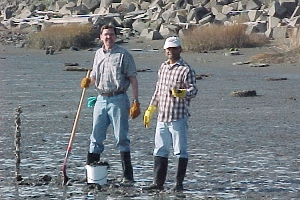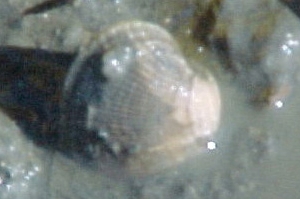 Collection of contaminated sediments from Hunters Point, San Francisco Bay Collection of contaminated sediments from Hunters Point, San Francisco Bay

Clam in PCB-contaminated sediment
|
IN SITU STABILIZATION OF PERSISTENT ORGANIC CONTAMINANTS IN MARINE SEDIMENTS
Investigators: Richard G. Luthy (Stanford), Upal Ghosh (UMBC), Richard N.
Zare (Stanford), Todd S. Bridges(WES)
Duration: October 2000 - March 2004.
Funding agency: Strategic Environmental Research and Developmental Program (DoD)
Background. Effective management of polychlorinated biphenyls
(PCBs) in sediments is challenging and expensive. Hydrophobic organic
compounds (HOCs) such as PCBs, PAHs, and DDT associate with fine-grained,
organic-rich, sediment material. This serves as a contaminant reservoir
in shallow estuarine and coastal regions from which fish and bottom-dwelling
organisms accumulate toxic compounds passed up the food chain. However,
recent work by our group and others proposes that the bioavailability
of hydrophobic organic contaminants depends on how weakly or strongly
they are sorbed
to sediment
organic matter. We find that black carbon particles in a wide variety
of sediments act as strong sorbents, which naturally over time tend
to concentrate HOCs and make these compounds less available for organisms.
Building on these observations, we have tested a new concept for sediment
management based on addition of activated carbon to sediment to repartition
hydrophobic organic compounds in the sediment, reducing biological
uptake and leaching into the overlying water.
Research Objectives. The objectives of the research are to investigate:
1. How are PAHs and PCBs distributed among marine sediment particle types?
2. How does the aqueous availability of PAHs and PCBs depend on the nature
of the marine sediment particle types and character of the sorbent organic
matter?
3. What form of coal-derived material (coke, activated
carbon) provides the right balance between material cost and sorption capacity
for PAHs/PCBs?
4. How does the introduction of a sorbent material affect the phase transfer
of PAHs and PCBs from marine sediment and thereby
reduce
the
aqueous availability of the organic contaminants?
5. How does the addition of
a sorbent material to sediment reduce the impact of PAHs and PCBs and benefit
the survival, growth,
and reproduction of marine organisms?
|